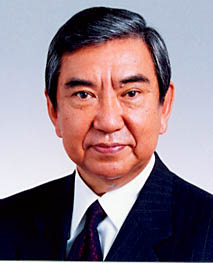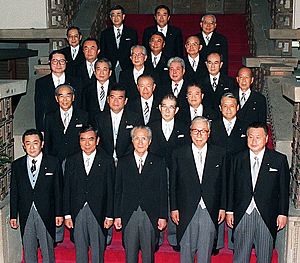Yōhei Kōno facts for kids
Quick facts for kids
Yōhei Kōno
|
|
|---|---|
|
河野 洋平
|
|

Official portrait, 1999
|
|
| Speaker of the House of Representatives | |
| In office 19 November 2003 – 21 July 2009 |
|
| Monarch | Akihito |
| Deputy | Kansei Nakano Takahiro Yokomichi |
| Preceded by | Tamisuke Watanuki |
| Succeeded by | Takahiro Yokomichi |
| Minister of Foreign Affairs | |
| In office 5 October 1999 – 26 April 2001 |
|
| Prime Minister | Keizo Obuchi Yoshiro Mori |
| Preceded by | Masahiko Kōmura |
| Succeeded by | Makiko Tanaka |
| In office 30 June 1994 – 11 January 1996 |
|
| Prime Minister | Tomiichi Murayama |
| Preceded by | Koji Kakizawa |
| Succeeded by | Yukihiko Ikeda |
| Deputy Prime Minister of Japan | |
| In office 30 June 1994 – 2 October 1995 |
|
| Prime Minister | Tomiichi Murayama |
| Preceded by | Tsutomu Hata |
| Succeeded by | Ryutaro Hashimoto |
| President of the Liberal Democratic Party | |
| In office 9 August 1993 – 2 October 1995 |
|
| Vice President | Keizō Obuchi |
| Secretary-General |
|
| Preceded by | Kiichi Miyazawa |
| Succeeded by | Ryutaro Hashimoto |
| Leader of the Opposition | |
| In office 9 August 1993 – 30 June 1994 |
|
| Prime Minister | Morihiro Hosokawa Tsutomu Hata |
| Preceded by | Sadao Yamahana |
| Succeeded by | Toshiki Kaifu |
| Chief Cabinet Secretary | |
| In office 12 December 1992 – 9 August 1993 |
|
| Prime Minister | Kiichi Miyazawa |
| Preceded by | Koichi Kato |
| Succeeded by | Masayoshi Takemura |
| Director-General of the Science and Technology Agency | |
| In office 28 December 1985 – 22 July 1986 |
|
| Prime Minister | Yasuhiro Nakasone |
| Preceded by | Reiichi Takeuchi |
| Succeeded by | Yataro Mitsubayashi |
| Member of the House of Representatives | |
| In office 29 January 1967 – 21 July 2009 |
|
| Preceded by | Multi-member district |
| Succeeded by | Yōsuke Kamiyama |
| Constituency | Kanagawa 3rd (1967–1976) Kanagawa 5th (1976–1996) Kanagawa 17th (1996–2009) |
| Personal details | |
| Born | 15 January 1937 Hiratsuka, Kanagawa, Japan |
| Political party | Liberal Democratic (before 1976; 1986–present) |
| Other political affiliations |
New Liberal Club (1976–1986) |
| Children | Taro Kono |
| Parent |
|
| Relatives | Kenzō Kōno (uncle) Seiichi Tagawa (cousin) |
| Alma mater | Waseda University |
Yōhei Kōno (河野 洋平, Kōno Yōhei, born 15 January 1937) is a Japanese politician. He was a very important leader in the Liberal Democratic Party (LDP). He served as the Speaker of the House of Representatives from 2003 to 2009. This is like being the head of one of Japan's main government groups.
He was the Speaker for the longest time since this role was created in 1890. Kōno also led the Japan Association of Athletics Federations from 1999 to 2013.
Early Life and Education
Yōhei Kōno was born on January 15, 1937. His hometown is Hiratsuka, Kanagawa, Japan. His father, Ichirō Kōno, was also a famous politician. His father was even a Deputy Prime Minister. He helped organize the 1964 Summer Olympics in Tokyo. Yōhei's uncle, Kenzō Kōno, was also a political leader. He was the head of the House of Councillors.
Yōhei Kōno went to Waseda University Senior High School. After that, he studied Economics at Waseda University. After finishing college, he worked for a company called Marubeni. In 1967, his father passed away. This led Yōhei Kōno to start his own career in politics.
Political Career and Leadership
Yōhei Kōno held many important jobs in the Japanese government. He was the Deputy Prime Minister of Japan from 1994 to 1995. This meant he had a lot of influence in the government at that time. He also served as the Minister of Foreign Affairs twice. This role involves managing Japan's relationships with other countries. He held this position from 1993 to 1995 and again from 1999 to 2001.
He was the President of the Liberal Democratic Party (LDP) from 1993 to 1995. The LDP is one of Japan's biggest political parties. Kōno is one of only two LDP leaders who never became Prime Minister of Japan. He was known for his views on international relations. He believed in strong ties with neighboring countries.
Kono Statement and Historical Understanding
As Chief Cabinet Secretary, Yōhei Kōno made an important official statement in 1993. This statement is known as the Kono Statement. In it, he acknowledged that the Imperial Japanese Army was involved in setting up certain facilities during World War II. He also recognized that women were recruited in ways that were not fair.
His statement encouraged more historical research and education. It aimed to help people understand and remember this part of history. This became a basis for how this topic was taught in school history textbooks.


